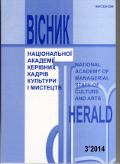THE TYPICAL NATURE OF PAREMIAE AND PHRASEOLOGICAL UNITS IN TRADITIONS OF SLAVS AND TURKIC PEOPLE OF THE CRIMEAN SOCIOCULTURAL SPACE
DOI:
https://doi.org/10.32461/2226-3209.3.2014.138099Keywords:
traditions, paremiae, polyethnic space, phraseological units, locality, universality, dialogue, macroethnic group, polyethnicityAbstract
Multiethnic associations under modern conditions of globalization and total domination of mass culture undergoes the process of activation of traditional forms of creativity, allowing to restore, save and transmit sensemaking principles of functioning of folk culture. This fact is of great significance in preserving cultural diversity of the world. The topicality of this research is determined by understanding of hidden in folk creativity mechanisms of functioning of sociocultural relations, realized in different forms of social communication, integration, culture-creating activity and cooperation of individuals and groups. All abobe mentioned determines the choice and actuality of this theme, raising the problem of research of folk creativity in modern polyethnic society.
To priceless pearls of Slavonic and Turkic folklore of the Crimea we will primarily refer proverbs and sayings –
short apt expressions. Proverbs and sayings are the generalized memory of people, conclusions made on the basis of
vital experience, giving the right to formulate one’s opinion on ethics, moral, history and policy. A proverb is a short form of folk poetic creation, turned into short, rhythmic expression, bearing the generalized opinion, conclusion, allegory with didactic content. A saying is a genre of folklore prose, a short stable image-bearing expression of ascertaining character with one sentence part, quite often being part of a proverb but without ending. In folkloristics proverbs and sayings are termed as paremiae.
In the article the similarities have been analysed between the proverbs and sayings of not only Ukrainian, Russian ethnic groups but those of the Crimean Bulgarians, Poles, Czechs, constituting together an integrated Slavonic ethnic picture of the peninsula. It is also necessary to say about phraseological units, which got identity due to historical commonality of Slavonic languages, close connection of phraseology with folk customs, ceremonies, rituals and traditions. The article analyses paremiae of Turkic people of the Crimea, determines the degree of their similarity; with this purpose the author appealed to the written sources of Turkic people of the Crimea. Particular attention was paid to rich material of Karaite related collections of Medzhuma, already collected, written down, but not yet published.
Usually in these collections, which look like large thick notebooks, the folk works such as fairy-tales, legends, novels, songs, riddles, proverbs, as well as different important events of that time, e.g., unusual natural phenomena
(earthquakes, eclipses of the sun and moon, etc.), a family chronicle, etc., were written down. Medzhuma passed from generation to generation. Often the families had several collections constituting a single chronologic order. Therefore they belonged to the most valuable family antiquities. Texts in them were written down from top to bottom throughout the length, and they opened from bottom to the top. Up to now ancient samples dated back to the end of the 18th century have been kept, though the majority of such famous manuscripts dated from the second half of XIX century to the middle of XX century. Their great number belong to state or private collections of Russia, Ukraine and Poland. Their greatest part was preserved in private and state libraries and funds of the Crimea, Saint Petersburg, Vilnius and Warsaw. However Medzhuma is considered to be an inexhaustible source of folk wisdom not only for Karaites. It saves the written monuments of culture of many Turkic people. They partially contain Old Turkic material, folklore works which were found in different Turkic ethnic groups of the Crimea. Such collections were also named "jonkies" (literally "a scroll"). They were composed by the Crimean Karaites, Crimean Tatars and Krymchaks.
Thus, the presence of common features in a form of presenting and establishing the sense of appreciating attitude toward native land, friendship, daily bread, labour is characteristic of paremia folklore of Turkic people. It can be
seen on the examples of fully identical names of edifications, parting words in the native Turkic people of the Crimea – "Atalar sozy", "Atalar stsy", "Atalar sÖzy", that expresses not only the unity of language (in translation "Parents’ Words") but also similar perception of environment. All these are universality of culture, traditions, lifestyle of Turkic people of the Crimea, as well as their common sources, common roots, common historical cradle.
Folk sayings, proverbs, phraseological units of two macroethnic groups use identical motives, subjects, epithets,
overflowing from the slavonic ethnos to the Turkic one and vice versa. Many moments seem to mix, turning into "twins", however deep inside, implicitly, every macroethnic part still preserves its own prototypes. This fact proves the dialogical essence of local and universal in the traditional culture of the Crimean polyethnic society.
Downloads
Published
Issue
Section
License
Authors who publish with this journal agree to the following terms:
1. Authors retain copyright and grant the journal right of first publication with the work simultaneously licensed under a Creative Commons Attribution License International CC-BY that allows others to share the work with an acknowledgement of the work's authorship and initial publication in this journal.
2. Authors are able to enter into separate, additional contractual arrangements for the non-exclusive distribution of the journal's published version of the work (e.g., post it to an institutional repository or publish it in a book), with an acknowledgement of its initial publication in this journal.
3. Authors are permitted and encouraged to post their work online (e.g., in institutional repositories or on their website) prior to and during the submission process, as it can lead to productive exchanges, as well as earlier and greater citation of published work (See The Effect of Open Access).


